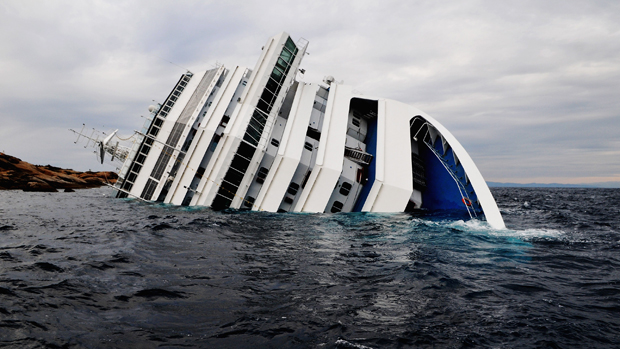Costa Concordia: operation to re-float liner begins
Largest maritime salvage operation begins, but activists fear re-floating Costa Concordia could harm dolphins

The final phase of the operation to salvage the wreck of the Costa Concordia is getting underway today, nearly two and half years after the tragedy occurred on the Italian island of Giglio.
The refloating and towing of the cruise-liner is set to be "the biggest maritime salvage operation in history", reports the Telegraph.
The ship crashed into rocks and capsized, killing 32 people in January 2012. It is hoped that the body of Russell Rebello, the last victim of the disaster not yet accounted for, will finally be discovered.
The Week
Escape your echo chamber. Get the facts behind the news, plus analysis from multiple perspectives.

Sign up for The Week's Free Newsletters
From our morning news briefing to a weekly Good News Newsletter, get the best of The Week delivered directly to your inbox.
From our morning news briefing to a weekly Good News Newsletter, get the best of The Week delivered directly to your inbox.
What has already been done?
Last September, the vessel was partially righted and left resting on six steel platforms.
How are they planning to re-float it?
Engineers will pump air into 30 tanks in the hull of the ship, forcing out seawater and – if all goes according to plan – raising the ship by 12 metres, the Telegraph reports.
A free daily email with the biggest news stories of the day – and the best features from TheWeek.com
Franco Gabrielli, the head of the civil protection agency overseeing the salvage, told the BBC that it would be "a very complex operation".
"The first phase of the operation will be the most dangerous because the vessel will be detached from the platforms," he said.
What happens next?
Once the vessel has been raised, several tug boats will then tow the wreckage 200 nautical miles to the port of Genoa, where it will be scrapped.
How long will it take?
If the weather is good, engineers predict the re-floating operation will take less than a week, and a further five days to tow the wreckage away. The entire scrapping process is estimated to take up to two years.
How much will it all cost?
The entire operation including raising, re-floating, towing and scrapping of the ship is expected to cost over €1.5 billion, according to the chief executive of Costa Cruises.
Reaction to the re-floating
Residents of the popular tourist island say they are relieved that the wreckage is finally being cleared. "I am happy they are taking it away because to see a ship like that always there, with the deaths that happened, it gives us the shivers," Italo Arienti told Reuters.
But environmentalists warn of a serious risk of pollution as the route to Genoa passes through a whale and dolphin reserve. They say that it should be taken to a closer port.
"We're worried about the duration of the journey, and the fact that it will pass through the marine sanctuary," said Cecilia Martinez from Greenpeace Italy. Activists are expected to the follow the vessel in small boat to monitor the situation, but said they would not take direct action.
-
 Political cartoons for January 4
Political cartoons for January 4Cartoons Sunday's political cartoons include a resolution to learn a new language, and new names in Hades and on battleships
-
 The ultimate films of 2025 by genre
The ultimate films of 2025 by genreThe Week Recommends From comedies to thrillers, documentaries to animations, 2025 featured some unforgettable film moments
-
 Political cartoons for January 3
Political cartoons for January 3Cartoons Saturday's political cartoons include citizen journalists, self-reflective AI, and Donald Trump's transparency
-
 How Bulgaria’s government fell amid mass protests
How Bulgaria’s government fell amid mass protestsThe Explainer The country’s prime minister resigned as part of the fallout
-
 Femicide: Italy’s newest crime
Femicide: Italy’s newest crimeThe Explainer Landmark law to criminalise murder of a woman as an ‘act of hatred’ or ‘subjugation’ but critics say Italy is still deeply patriarchal
-
 Brazil’s Bolsonaro behind bars after appeals run out
Brazil’s Bolsonaro behind bars after appeals run outSpeed Read He will serve 27 years in prison
-
 Americans traveling abroad face renewed criticism in the Trump era
Americans traveling abroad face renewed criticism in the Trump eraThe Explainer Some of Trump’s behavior has Americans being questioned
-
 Nigeria confused by Trump invasion threat
Nigeria confused by Trump invasion threatSpeed Read Trump has claimed the country is persecuting Christians
-
 Sanae Takaichi: Japan’s Iron Lady set to be the country’s first woman prime minister
Sanae Takaichi: Japan’s Iron Lady set to be the country’s first woman prime ministerIn the Spotlight Takaichi is a member of Japan’s conservative, nationalist Liberal Democratic Party
-
 Russia is ‘helping China’ prepare for an invasion of Taiwan
Russia is ‘helping China’ prepare for an invasion of TaiwanIn the Spotlight Russia is reportedly allowing China access to military training
-
 Interpol arrests hundreds in Africa-wide sextortion crackdown
Interpol arrests hundreds in Africa-wide sextortion crackdownIN THE SPOTLIGHT A series of stings disrupts major cybercrime operations as law enforcement estimates millions in losses from schemes designed to prey on lonely users